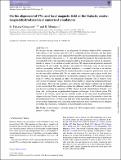Files in this item
On the alignment of PNe and local magnetic field at the Galactic centre : magnetohydrodynamical numerical simulations
Item metadata
| dc.contributor.author | Falceta-Gonçalves, D. | |
| dc.contributor.author | Monteiro, H. | |
| dc.date.accessioned | 2014-09-09T11:01:08Z | |
| dc.date.available | 2014-09-09T11:01:08Z | |
| dc.date.issued | 2014-03-11 | |
| dc.identifier | 146984388 | |
| dc.identifier | 9879756e-2327-43c7-a2d2-b9534fc619c4 | |
| dc.identifier | 84894361217 | |
| dc.identifier | 000332038000010 | |
| dc.identifier.citation | Falceta-Gonçalves , D & Monteiro , H 2014 , ' On the alignment of PNe and local magnetic field at the Galactic centre : magnetohydrodynamical numerical simulations ' , Monthly Notices of the Royal Astronomical Society , vol. 438 , no. 4 , pp. 2853-2863 . https://doi.org/10.1093/mnras/stt2393 | en |
| dc.identifier.issn | 0035-8711 | |
| dc.identifier.uri | https://hdl.handle.net/10023/5390 | |
| dc.description | DFG thanks the European Research Council (ADG-2011 ECOGAL), and Brazilian agencies CNPq (no. 300382/2008-1), CAPES (3400-13-1) and FAPESP (no.2011/12909-8) for financial support. HM thanks CNPq grant 573648/2008-5 and FAPEMIG grants APQ-02030-10 and CEX-PPM-00235-12. | en |
| dc.description.abstract | For the past decade, observations of the alignment of planetary nebulae (PNe) symmetries with respect to the Galactic disc have led to conflicting results. Recently, the first direct observational evidence for a real alignment between PNe and local interstellar magnetic fields in the central part of the Galaxy (b <5°) has been found. Motivated by the recent discovery, we studied the role of the interstellar magnetic field on the dynamical evolution of a planetary nebula by means of an analytical model and from 3D magnetohydrodynamical numerical simulations. In our models, the nebula is the result of a short-time event of mass ejection with its surrounding medium. The nebula asphericity is assumed to be due to an intrinsic shaping mechanism, dominated by the latitude-dependent asymptotic giant branch wind, and not the interstellar medium field. We test under what conditions typical ejecta would have their dynamics severely modified by an interstellar magnetic field. We found that uniform fields of > 100 μG are required in order to be dynamically dominant. This is found to occur only at later evolutionary stages, therefore, being unable to change the general morphology of the nebula. However, the symmetry axis of bipolar and elliptical nebulae end up aligned to the external field. This result can explain why different samples of PNe result in different conclusions regarding the alignment of PNe. Objects located at high Galactic latitudes, or at large radii, should present no preferential alignment with respect to the Galactic plane. PNe located at the Galactic centre and low latitudes would, on the other hand, be preferentially aligned to the disc. Finally, we present synthetic polarization maps of the nebulae to show that the polarization vectors, as well as the field lines at the expanding shell, are not uniform even in the strongly magnetized case, indicating that polarization maps of nebulae are not adequate in probing the orientation, or intensity, of the dominant external field. | |
| dc.format.extent | 11 | |
| dc.format.extent | 4728695 | |
| dc.language.iso | eng | |
| dc.relation.ispartof | Monthly Notices of the Royal Astronomical Society | en |
| dc.subject | Hydrodynamics | en |
| dc.subject | Methods: numerical | en |
| dc.subject | ISM: magnetic fields | en |
| dc.subject | Planetary nebulae: general | en |
| dc.subject | Galaxy: bulge | en |
| dc.subject | QB Astronomy | en |
| dc.subject | QC Physics | en |
| dc.subject.lcc | QB | en |
| dc.subject.lcc | QC | en |
| dc.title | On the alignment of PNe and local magnetic field at the Galactic centre : magnetohydrodynamical numerical simulations | en |
| dc.type | Journal article | en |
| dc.contributor.sponsor | European Research Council | en |
| dc.contributor.institution | University of St Andrews. School of Physics and Astronomy | en |
| dc.identifier.doi | 10.1093/mnras/stt2393 | |
| dc.description.status | Peer reviewed | en |
| dc.identifier.grantnumber | en |
This item appears in the following Collection(s)
Items in the St Andrews Research Repository are protected by copyright, with all rights reserved, unless otherwise indicated.

